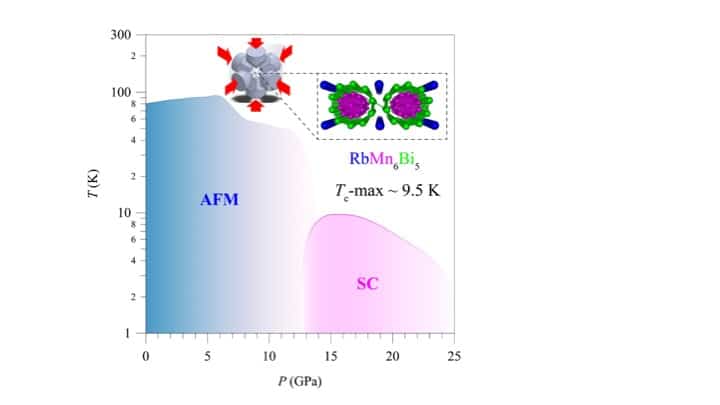Manganese joins a new family of superconductors
18 Jul 2022 Isabelle Dumé
The T-P phase of RbMn6Bi5 and the high-pressure approach. Courtesy: J-G Cheng
Researchers from the Institute of Physics, Chinese Academy of Sciences, Beijing, have spotted the tell-tale signs of superconductivity in a quasi-one-dimensional manganese-based material, RbMn6Bi5. The material, which has a superconducting transition temperature (Tc) of 9.5 K at a pressure of around 15 GPa, is the latest in a relatively new family of superconductors, the first of which was discovered in 2015 by the same group.
The classical theory of superconductivity (known as BCS theory after the initials of its discoverers) states that below a specific critical temperature, the fermionic electrons in a metal can pair up to create bosons called Cooper pairs. These bosons form a phase-coherent condensate that can flow through a material without scattering – with superconductivity as a consequence.
Mn-based superconductors
In 2015, researchers led by Jin-Guang Cheng discovered the first manganese-based superconductor, MnP. This material has a very low Tc of just 1 K, and its properties are difficult to control because it is a three-dimensional binary molecule. Nevertheless, the fact that it superconducts at all was something of a surprise since conventional wisdom held that manganese-based materials cannot do so. Since then, the group has been screening other Mn-based magnetic materials under high pressures in the hopes of unearthing further examples of superconductivity.
In the new work, the team found what they were looking for in a group of one-dimensional ternary or complex Mn-based compounds. “This study and another related one published in Physical Review Letters establish AMn6Bi5 (where A=K or Rb) as a new class of ternary Mn-based superconductors with relatively high Tc,” Cheng explains. “The optimal Tc reaches almost 10 K, which is an order of magnitude higher than that of MnP, implying that the Tc of Mn-based superconductors has the potential to go higher.”
Cheng adds that the quasi-one-dimensional crystal structures and chemical composition of materials in the AMn6Bi5 family make it easier to tune their physical properties through chemical substitutions and/or other structural/electronic regulations. This means that such materials could be used as the basis for designing other Mn-based superconductors.
“Quantum criticality”
In addition to the material’s relatively high Tc, Cheng and colleagues found that the upper critical field for the superconducting state (that is, the field at which superconductivity disappears) is also high, exceeding the Pauli paramagnetic limit Hp=1.84 Tc. According to Cheng, this implies the presence of strong electron-phonon coupling or exotic pairing mechanisms.READ MORE

The researchers now plan to investigate the nature of the material’s superconductivity using microscopic probes such as nuclear magnetic resonance measurements. “We also hope to tune the physical properties of K/RbMn6Bi5 at ambient pressure through techniques such as chemical substitutions and gate-voltage regulations,” Cheng tells Physics World. “Ultimately, our goal is to find a Mn-based superconductor at ambient pressure with a Tc of over 10 K.”
They detail their work in Chinese Physics Letters.

Isabelle Dumé is a contributing editor to Physics World.
from physicsworld.com 20/7/2022

Δεν υπάρχουν σχόλια:
Δημοσίευση σχολίου